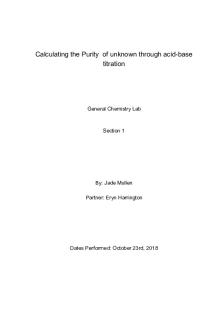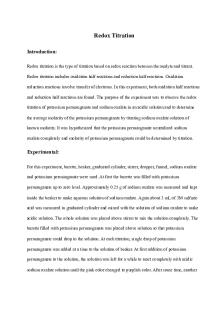Acid-Base Titration Lab Report PDF

| Title | Acid-Base Titration Lab Report |
|---|---|
| Author | Yamilet Guzman |
| Course | Chemistry Lab 1 |
| Institution | Benedict College |
| Pages | 7 |
| File Size | 88.3 KB |
| File Type | |
| Total Downloads | 94 |
| Total Views | 169 |
Summary
Download Acid-Base Titration Lab Report PDF
Description
Running head: ACID-BASE TITRATION
Acid-Base Titration Lab Report 1 Chem 118L 01 Isaiah Tealey Dr.Changyong Qin 3/5/2020
1
ACID-BASE TITRATION
2 Abstract
The purpose of this lab was to titrate an acid of an unknown concentration with a base of a known concentration so as to determine the unknown concentration of the acid. The measure of acid emitted the light pink shade that changed into made on this test starting the examination with the base NaOH(Sodium Hydroxide) continuing the investigation by method for including the corrosive HCL(Hydrochloric Acid). Consolidating the HCL to the NaOH will emit the red color. The phenolphthalein permits us to know the conclusive outcomes of this test because of the response.
ACID-BASE TITRATION
3 Acid-Base Titration Introduction
Titration is the neutralization of an acid and base so as to determine an unknown concentration of either of the aforementioned things. This is generally demonstrated with the aid of a shading exchange by means of a pH tracker, as an example, phenolphthalein. The indicator will change colors relying on the pH to give us when the response is completely balanced. The pen will flip the affiliation a light concealing while it has shown up at its endpoint, yet note that the lighter shade of shade the affiliation turns, the more prominent and amazing the preliminary has been finished. The solution that traverses a darker concealing shows you have made considerable progress past the endpoint and that the game plan is excessively titrated. It is anything but difficult to advise when the parameter has come in light of the fact that the affiliation will substitute shade. We know that the mixing of equal amounts of acid and base ions will create neutral water. At the molecular level, this reaction can be illustrated with the following equation. (H+) +( OH-) =H2O (acid) (base) This equation states that one mole of hydrogen ions (acid) will neutralize one mole of hydroxide ions (base). Since we can exactly measure the moles of the standard solution, we can assume that the moles of the solution of unknown concentration will be the same at the neutral point.
Materials and Methods
We began this test by washing the burette with 10mL of clean water. At that point, we
ACID-BASE TITRATION
4
flush every buret with around 10 mL of a solution than it is to hold – wash the corrosive containing buret with the HCl arrangement and the base-containing buret with the NaOH solution. It was permitting 40mL of the corrosive to come up short on the buret tip to flush them, continuing the test by including 50mL of NaOH into the buret. Spot a 125 mL flask under the corrosive buret. Next, we added 10.0 mL of corrosive to the compartment. Utilize your wash container to ensure all drops make it to the base of the jar; flush any slides that stay on the edges of the vial. Continue with the analysis by perusing the buret cautiously and record both the underlying and last volumes from the buret into your information work area.
It might be extremely important which you precisely study and document the underlying and last volumes. It isn't fundamental that the burets be full to a quite certain imprint (0.0 mL) toward the beginning of the titration, yet it's far crucial that the degree in no way, shape or form move beneath the base imprint (50.Zero mL). Be sure to examine the base of the glass at eye level. You may likewise think that its helpful to keep up a white card with an enormous dark streak or square shape in the rear of the buret to make it simpler to contemplate. Finishing up the system by adding three drops of phenolphthalein to the flagon and whirl the jug to consolidate altogether.
Results
Part A
ACID-BASE TITRATION
5
Trial
Calculations
[NaOH]
1
0.1 x 10/6
= 1.66
2
0.1 x 11/10
= .11
3
0.1 x 10/ 4
= .25
4
0.1 x 10/2
= .5
Average
------------------
.(25)675… 0.26
Calculating the concentration of the vinegar solution Trial
Calculations
[HC2H3O2]
1
0.1 x 10/10=
0.1
2 #3) 0.1x 10/14.7=0.068
0.1x 10/15.5=
0.064
4
0.1x10/ 9.8=
0.102
Average
---------------------
.0835
Part B
Class data for the concentration of the vinegar solution Group
[NaOH]
1
0.283
2
0.49
3
0.23
etc.
-------------
Average
.334
ACID-BASE TITRATION
6
Discussion The motivation behind this investigation was to set up how much base is required with a particular measure of acid. We knew about the hydrochloric corrosive being more responsive than acetic acid in light of the fact that the acetic acid required extra NaOH, this response made the Acetic corrosive balance and the required hydrochloric acid few mL to the base for balance. The Acetic acid demonstrated higher polarity. Which drove our normal too. 0835 for the convergence of the arrangement. The Hydrochloric acid molarity was 0.1, which implies the Acetic corrosive was less reactant.
Conclusion The volume of water applied in this experiment to clean droplets of acid from the desk or as water poured into the acid in the flask now does not influence the calculations and does not want to be accounted for any longer, according to the lab released. It displays the proportion of the ratio 1:1 between the acid and base. When the experiment was successfully done, we were able to complete we were able to discover the unknown, while measuring our effects on vinegar titration. This research was a success as we were finding part B unknown.
ACID-BASE TITRATION
7
Reference
file:///home/chronos/u82add2900f3a42719ecf713114082d15bc63b781/MyFiles/Downloads/acis_base_titration %20(1).pdf...
Similar Free PDFs

Titration Worksheet - Lab Report
- 2 Pages

Lab Report titration curve
- 7 Pages

Back titration - chem lab report
- 2 Pages

Acid base titration lab report
- 5 Pages

Acid-Base Titration Lab Report
- 7 Pages

Chemistry Report Titration 1
- 5 Pages
Popular Institutions
- Tinajero National High School - Annex
- Politeknik Caltex Riau
- Yokohama City University
- SGT University
- University of Al-Qadisiyah
- Divine Word College of Vigan
- Techniek College Rotterdam
- Universidade de Santiago
- Universiti Teknologi MARA Cawangan Johor Kampus Pasir Gudang
- Poltekkes Kemenkes Yogyakarta
- Baguio City National High School
- Colegio san marcos
- preparatoria uno
- Centro de Bachillerato Tecnológico Industrial y de Servicios No. 107
- Dalian Maritime University
- Quang Trung Secondary School
- Colegio Tecnológico en Informática
- Corporación Regional de Educación Superior
- Grupo CEDVA
- Dar Al Uloom University
- Centro de Estudios Preuniversitarios de la Universidad Nacional de Ingeniería
- 上智大学
- Aakash International School, Nuna Majara
- San Felipe Neri Catholic School
- Kang Chiao International School - New Taipei City
- Misamis Occidental National High School
- Institución Educativa Escuela Normal Juan Ladrilleros
- Kolehiyo ng Pantukan
- Batanes State College
- Instituto Continental
- Sekolah Menengah Kejuruan Kesehatan Kaltara (Tarakan)
- Colegio de La Inmaculada Concepcion - Cebu









